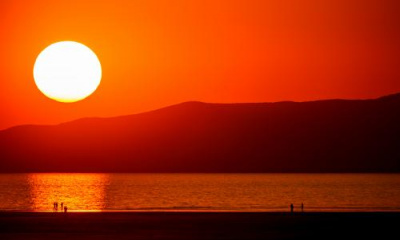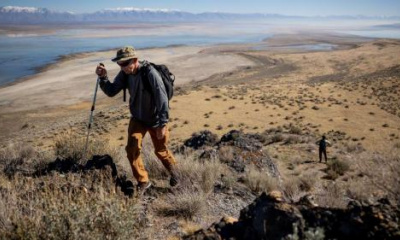Call it Antelope Island, but by no means is it an island.
Same goes for Fremont Island, Stansbury Island, Gunnison Island and other smaller land masses — like Hat and Carrington islands — that used to poke up out of the Great Salt Lake, say wildlife officials and others who study the lake. The “island” part of their names remains, but as the lake level has dipped to historic lows, what were once land masses surrounded by salty water when the lake’s level was higher have connected to the mainland.
“There are no longer any islands on the Great Salt Lake,” said Jaimi Butler, a field biologist and former coordinator at the Great Salt Lake Institute at Westminster College in Salt Lake City. “They’re all connected by land bridges.”
It’s certainly a shift that’s materialized since last year when the lake level dipped below the prior historic low registered in 1963. Public hand-wringing about the Great Salt Lake’s dire plight, however, has surged in the past year. It’s been in the offing as humans have increasingly diverted the water that once flowed into the lake and as drought conditions cause more evaporation.
Look at U.S. Geological Survey aerial maps of the lake from 1985 to 2021, featured on its website, and the change is apparent — the lake’s surface has dipped from 3,300 square miles to 941 square miles in the span. A Utah Geological Survey report from 2010 said the Great Salt Lake contains 17 “officially named islands” but even then noted that the actual number of true islands depended on the lake’s water level at the time.
The absence of islands “has been the case for the last several years. We probably haven’t had islands for quite some time,” said John Luft, director of the Utah Division of Wildlife Resources’ Great Salt Lake Ecosystem Program.
Whatever the case, it’s one more reminder of the Great Salt Lake’s change over the years. And it prompted a wry quip from Bonnie Baxter, the director of the Great Salt Lake Institute, about the buffalo that roam Antelope Island just northwest of Salt Lake City International Airport.
“They could walk to the airport now,” she said. “They could walk into Salt Lake City.”
Buffalo meandering among the skyscrapers of Salt Lake City probably won’t happen, says Xaela Walden, a Utah Division of Wildlife Resources biologist. Part of the southern side of Antelope Island is fenced, for one thing, and she said buffalo typically don’t wander too far afield from their usual stomping grounds.
But the disappearance of the protective moat of water around the dots of land of the Great Salt Lake has larger potential implications to the critters that live on the so-called islands. There are the bighorn sheep on Antelope Island, for instance, and the American white pelicans on Gunnison Island in the northwest part of the lake.
In late 2018, pneumonia was detected among the bighorn sheep of Antelope Island, possibly introduced — though officials aren’t 100% sure — by a domestic sheep that wandered into the area from the mainland, according to Luft. The outbreak decimated the whole herd, prompting installation of the fence along the south side of Antelope Island.
“As of right now, (the fence) is still effective. It may need to be extended further if the lake continues to dry,” Walden said. A new herd of bighorn sheeps came to Antelope Island and the animals are doing fine.
Further north in the North Arm of the lake, Gunnison Island “is home to one of the largest breeding colonies of American white pelicans in the world,” reads a study on the birds authored by Luft, Butler and others from the Utah Division of Wildlife Resources and the Utah Department of Natural Resources. The report, “American White Pelicans of Gunnison Island, Great Salt Lake, Utah,” appears as a chapter in the 2020 book, “Great Salt Lake Biology: A Terminal Lake in a Time of Change.”
The island connected to the mainland around 2016, however, giving access to predators like coyotes and foxes. Experts think coyotes are more interested in the mice and other rodents on the island, not the pelicans, but still, the shift has implications.
“Any disturbance will flush (pelicans) off their nests,” Butler said. Thus, if a pelican flies off, scared by a land predator, the eggs or chicks left behind, while of no interest to a coyote, may draw the attention of a hungry seagull.
“We have seen an impact to the population,” Butler said, though the report she helped complete indicates more research is needed.
The 2020 report indicates that the drought conditions dry out freshwater marshes and ponds, “reducing forage habitat” for pelicans, which is part of a trend that dates to the 1940s. A colony on Hat Island, also in the Great Salt Lake, “never truly recovered” from the varied pressures. Indeed, Butler thinks pelicans have used Gunnison Island as a nesting spot because of the protection brought on by being surrounded by water and she worries about their long-term presence.
Beyond the impacts to wildlife, Baxter worries about people increasingly trying to access islands via the land bridges that have opened. Some of the bridges, she warns, can still be muddy and mucky and that could lead to would-be explorers getting stuck.
Beyond the threats to critters and people, the disappearance of the Great Salt Lake’s islands spurs a measure of sadness and sentimentality among some.
Mayor Dale Fowers of Hooper, which encompasses Fremont Island off the extreme western portion of Weber County’s mainland, remembers traveling there in mid-2020, driving via a high, relatively dry corridor heading north off the causeway to Antelope Island.
“We drove all the way out there. We got into some muddy stuff, but we never got into water,” he said.
He thinks it’s worse now — even drier — and lamented the turn of events.
“We were pleased being the only city in the state of Utah with an island in it. I hate to see that recognition go away,” he said.

.jpg)






